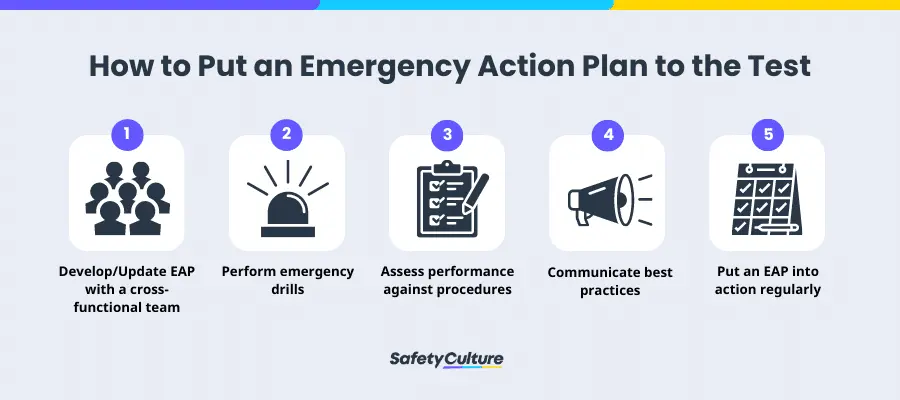What is an Emergency Action Plan?
An Emergency Action Plan (EAP) is a procedure that outlines how to respond and react during an emergency. The purpose of an EAP is to provide structure and smoothness in stressful situations, reducing the effects of chaos and uncertainty caused by an emergency.
An EAP describes who will take action with what tasks when there is an emergency, laying out specific steps that need to be taken for the organization or business to ensure people’s safety, property protection, continuity of operations, and minimizing business disruption.
Finally, it is essential to periodically review and update your EAP documents based on findings from any drills or actual events, which may require changes to keep them accurate in their application when needed.
Importance of the Plan and Why it Should be Updated
An emergency action plan is vital for every organization to prepare and execute emergency management protocols and procedures. The purpose of an EAP is to help the organization eliminate confusion, injury, or property damage in case of a workplace emergency (e.g., blasting).
Updating workplace emergency action plans is not only crucial for proper guidance during operational emergencies, but it can also keep revealing unrecognized hazardous conditions that may worsen an emergency situation, allowing safety and health professionals to apply preventive measures. Moreover, an outdated emergency action plan can lead to devastating losses such as multiple casualties and the financial downfall of an organization.
Benefits
Below are the main benefits of having an EAP in place:
-
Organize and Facilitate Workplace Emergencies for Employers and Employees
Employers need to have a plan for workers to follow in an emergency. This plan should include specific steps for employees, such as locking all doors, closing windows, turning off lights, and gathering in designated areas away from danger.
-
Injury Rates Are Lower and Less Severe
Having a plan and regularly training employees on what to do during an emergency can help reduce the risk of injuries. Employees will understand what steps to take and be better prepared for a situation.
-
There is Less Damage to the Structure
It’s not always possible to completely avoid destruction to the structure during an emergency. You can, however, minimize the damage and conduct repairs quickly and safely. An EAP can help you identify the steps needed to protect your building and property, such as shutting off gas and electricity or taking other preventive measures.
-
Reduce Financial Losses
The cost of an emergency can add up quickly. Insurance premiums may rise, and you may have to pay for repairs and replacement costs if items are damaged or destroyed. An EAP helps you plan by outlining procedures to minimize financial losses in an emergency. And it can help you complete the paperwork correctly so that your claim is processed as quickly as possible.
-
Establish Clear Communication
In an emergency, everyone must know their roles and responsibilities. An EAP outlines the chain of command for decision-making and communication during a critical event. Keeping everyone on the same page reduces confusion and keeps employees safe.
-
Ensure Continuity of Operations
An EAP also provides instructions for maintaining operations after an emergency. For example, it can describe strategies for keeping essential functions running during a power outage or suggest alternate locations if a facility is unavailable. It helps minimize downtime and ensure business continuity.
Who Needs an Emergency Action Plan?
As defined by the Occupational Safety and Health Administration (OSHA) in Standard 1910.38(a), every company or organization must have an EAP. Everyone can benefit from creating an EAP, from small firms to large organizations. It’s vital for companies with guests, customers, or on-site travelers, as well as those operating in risk-prone areas. An EAP can guarantee that everybody knows probable dangers and understands how to react if an unexpected situation occurs.
Individuals can also benefit from having an EAP. It ensures they are prepared in case of any potential calamity, comprehend what to do when disaster strikes, and remain safe while guarding their assets during a crisis.
Take Control of Your Workplace Safety Today with SafetyCulture
Eliminate manual tasks and streamline your operations.
Get started for FREEKey Components of an EAP
No two EAPs are alike, and the particularities of each will depend on many factors, such as building construction, operating hours, staff qualifications, and more. Despite this, there should typically be some universal components incorporated into most EAPs, including:
Procedures for Evacuation, Escape Routes, and Floor Plans
Detailed diagrams of building layouts are a crucial component of each EAP. No matter the emergency, it must feature an updated diagram for the whole property. The map should include marked pathways to safety, and all emergency exits must be unmistakable.
Keep in mind this data isn’t solely posted for the advantage of workers; visitors, comprising rescue personnel, will rely on this information to move around the building securely.
Instructions on How to Report and Alert Authorities
It is important to remember that specific emergencies require the presence of specialized emergency responders, such as a hazardous materials unit for chemical spills or a utility company for power lines and utility issues. Therefore, the EAP must have all relevant contact information and emergency numbers.
Procedures for Alerting Staff and Visitors During an Emergency
Other than calling on the proper authorities, it is crucial to let staff and visitors know that an emergency is happening. The suitable way of announcing will depend on the design, size, and type of the place and distress. For instance, sounding the fire alarm is possibly the most effective approach to facing flames. Other alert systems may entail blowing a whistle (e.g., aquatic EAPs) or striking a bell.
Accounting for Everyone after Implementing an EAP
Regrouping is the next step after executing an EAP. In an emergency, accounting for personnel can be made easier by having a printed roster and requesting individuals to indicate their safety when in a safe location. Moreover, assigning each party a particular area to gather to facilitate the check-in process is wise.
Procedures for Notifying the Parents, Guardians, or Next of Kin
Once an EAP is implemented, it can be necessary to tell parents, guardians, or next of kin connected to the persons concerned. Depending on the situation, family members may have to be told immediately to bring advice or come and take their kids away.
A finely-crafted EAP will explain who is notifying kindred, what emergencies necessitate informing relatives, and what data should be communicated. It is also essential to keep up-to-date contact facts for all participants.
Procedures for Identifying a Media Contact Person
A reporter may contact your organization in an emergency to get information. Addressing the press is imperative, and you should discern one person in your organization as the contact for media inquiries.
Instruct all personnel at your company to redirect any requests from reporters and civilians to this single individual. This person must be adequately trained to attentively answer delicate questions and know what facts can and cannot be shared.
Instructions on How to Train New Staff
New staff must be familiar with the emergency exits in case of an emergency. Furthermore, they should identify multiple doors in case one is inaccessible due to a particular crisis. For example, if there was a chemical spill, staff should be trained to stay away from the exits closest to the area and find another means of evacuating the building safely.
Policies for Updating and Maintaining the EAP
Keeping all EAPs up to date is no small task, yet it is the only way to guarantee a competent emergency reaction. EAPs should be inspected and improved annually or more often as called for. The documentation should note any upgrades. Fresh recruits, building reconfigurations, new ventures, office transformations, makeovers, and even more can all impact the potency of an EAP.
How to Put an Emergency Action Plan to the Test
Since emergencies in the workplace will occur, safety and health managers should ensure that every worker is prepared to respond accordingly. Follow these simple ways to inculcate the practice of an emergency action plan in an organization:

1. Develop or update the emergency action plan with a cross-functional team
The Canadian Centre for Occupational Health and Safety (CCOHS) recommends that relevant individuals such as employees with knowledge of the work, employees with experience in investigations, and representatives from the local government should participate in establishing or reviewing emergency procedures. Working with a cross-functional team helps make the emergency action plan be more all-encompassing, accurate, and aligned with reality.
2. Perform announced or unannounced emergency drills
With an EAP in place, the designated responsible official should conduct an organization-wide emergency drill to determine how effectively the plan is carried out. Announced emergency drills remind emergency coordinators to review the emergency action plan, while unannounced emergency drills demonstrate how they understand what to do at the onset of emergencies. For future reference, use an emergency drill checklist to record what happened in real-time. After each drill, put together a combined evaluation from both the management and the employees.
3. Assess performance against procedures in the emergency action plan
Upon completing emergency drills, gather a cross-functional team to look analyze the results. Determine the root cause of misalignment between performance and procedures, and exchange ideas about what can be done to maintain a high level of proficiency. The OSHA EAP template contains 21 critical questions to help assess the effectiveness of an emergency action plan.
4. Communicate best practices, areas of improvement, and changes to be applied
Positive reinforcement makes it easier for employees to keep doing what they did right. The designated responsible official and emergency coordinators should call out best practices such as remembering to deal with the spill in accordance with the instructions described in the material safety data sheet if the emergency drill was a chemical spill. Changes to be applied for areas of improvement should be partnered with proper training to sustain retention better.
5. Put an EAP into action regularly
OSHA advises annual emergency drills for the effective implementation of an emergency action plan. SafetyCulture suggests putting an emergency action plan to the test periodically (e.g. quarterly for organizations in high-risk industries such as construction and manufacturing or biannually for organizations in medium to low-risk industries such as retail and hospitality) to ensure the effectiveness of site-specific emergency procedures and continuously build a proactive safety culture in the workplace.
FAQ About Emergency Action Plans
It is recommended to review and update an EAP at least once a year to ensure it is up to date and takes into account any changes in the workplace or emergency response protocols. Additionally, it is essential to update EAPs when there are significant changes in personnel, building or equipment configurations, or new business activities.
Finally, assess whether more training is needed, if the plan needs to be revised, or if any upgrades are needed and update the documentation accordingly.
Measuring an emergency plan’s success largely depends on how quickly it can restore normal operations after a major incident. It is a crucial measure because even short downtime can cost businesses dearly—potentially making the difference between survival and failure.
Employers must review the emergency plan with each employee following OSHA regulation [29 CFR 1910.38(e)], both when the plan is created and when the employee first takes up their role. It ensures that every employee knows what to do in an emergency and is kept up-to-date with any changes.
Once Emergency Response Exercises have been verified to be effective, they should be tested within a year. These tests aim to refine and improve the plan and confirm that all employees know their responsibility in an emergency. After these tests, employers should make any necessary changes to ensure that their Emergency Action Plan remains effective.
It is the employer’s responsibility to establish and implement emergency action plans, as well as share information about them. However, it is also the responsibility of the employee to remember these plans and follow them.
What makes a good emergency plan?
A good emergency plan contains the following:
- Contact details of who to contact in case of emergency
Evacuation plans that consider different locations and situations
Proper practices to follow when evacuating or dealing with a risk
Plans for what to do after an incident




